煤化工厂硫铵工段设计论文中英文摘要资料
硫铵工段工艺详述

硫铵⼯段⼯艺详述第三章⼯艺详述⼀、硫酸铵⽣产的原理1.硫酸铵⽣成的化学原理氨与硫酸发⽣的中和反应为2NH 3+H 2S04→(NH 4)2S04 ΔH = -275kJ/mol上述反应是不可逆放热反应,当⽤硫酸吸收煤⽓中的氨时,实际的热效应较⼩。
通过实验得知,如氨和游离酸度为7.8%的硫酸饱和母液相互作⽤时,其反应热效应为温度/℃ 47.4 66.3 76.1硫酸铵热效应/(kJ/mo1) 240.9 245.9 249.2⽤适量的硫酸和氨进⾏反应时,⽣成的是中式盐(NH4)2S04,当硫酸过量时,则⽣成酸式盐NH4HS04,其反应为NH 3 + H2S04→酸过量(NH 4)HS04 ΔH = -165kJ/mol 随溶液被氨饱和的程度,酸式盐⼜可转变为中式盐NH 4HS04 + NH 3 → (NH 4)2S04溶液中酸式盐和中式盐的⽐例取决于母液中游离硫酸的含量,这种含量以质量分数表⽰,称之为酸度。
当酸度为1%~2%时,主要⽣成中式盐。
酸度升⾼时,酸式盐的含量也随之提⾼。
饱和器中同时存在两种盐时,由于酸式盐较中式盐易溶于⽔或稀硫酸中,故在酸度不⼤的情况下,从饱和溶液中析出的只有硫酸铵结晶。
由硫酸铵和硫酸氢铵在不同含量的硫酸溶液(60℃)内的溶解度⽐较可知,在酸度⼩于19%时,析出的固体结晶为硫酸铵;当酸度⼤于19%⽽⼩于34%时,则析出的是硫酸铵和硫酸氢铵两种盐的混合物;当酸度⼤于34%时,得到的固体结晶全为硫酸氢铵。
饱和器中被硫酸铵和硫酸氢铵所饱和的硫酸溶液称为母液。
正常⽣产情况下母液的⼤致规格为:密度/(kg/L) 1.275~1.30 w[(NH4)2S04]/% 40~60游离硫酸含量/% 4~6 w(NH4HS04)/% 10~15NH3的含量/(g/L) 150~180母液的密度是随母液的酸度增加⽽增⼤的。
⼆、硫酸铵⽣产⼯艺流程1.⿎泡式饱和器法硫酸铵⽣产⼯艺流程⿎泡式饱和器法硫酸铵⽣产⼯艺流程如图1所⽰。
节水论文(硫铵)
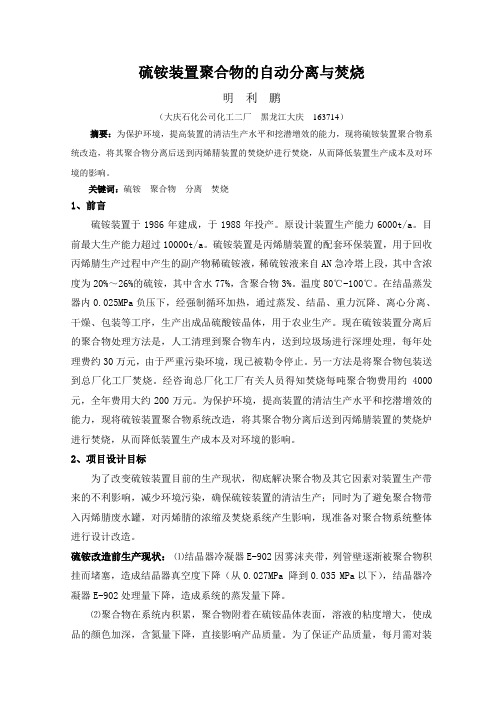
硫铵装置聚合物的自动分离与焚烧明利鹏(大庆石化公司化工二厂黑龙江大庆163714)摘要:为保护环境,提高装置的清洁生产水平和挖潜增效的能力,现将硫铵装置聚合物系统改造,将其聚合物分离后送到丙烯腈装置的焚烧炉进行焚烧,从而降低装置生产成本及对环境的影响。
关键词:硫铵聚合物分离焚烧1、前言硫铵装置于1986年建成,于1988年投产。
原设计装置生产能力6000t/a。
目前最大生产能力超过10000t/a。
硫铵装置是丙烯腈装置的配套环保装置,用于回收丙烯腈生产过程中产生的副产物稀硫铵液,稀硫铵液来自AN急冷塔上段,其中含浓度为20%~26%的硫铵,其中含水77%,含聚合物3%。
温度80℃-100℃。
在结晶蒸发器内0.025MPa负压下,经强制循环加热,通过蒸发、结晶、重力沉降、离心分离、干燥、包装等工序,生产出成品硫酸铵晶体,用于农业生产。
现在硫铵装置分离后的聚合物处理方法是,人工清理到聚合物车内,送到垃圾场进行深埋处理,每年处理费约30万元,由于严重污染环境,现已被勒令停止。
另一方法是将聚合物包装送到总厂化工厂焚烧。
经咨询总厂化工厂有关人员得知焚烧每吨聚合物费用约4000元,全年费用大约200万元。
为保护环境,提高装置的清洁生产水平和挖潜增效的能力,现将硫铵装置聚合物系统改造,将其聚合物分离后送到丙烯腈装置的焚烧炉进行焚烧,从而降低装置生产成本及对环境的影响。
2、项目设计目标为了改变硫铵装置目前的生产现状,彻底解决聚合物及其它因素对装置生产带来的不利影响,减少环境污染,确保硫铵装置的清洁生产;同时为了避免聚合物带入丙烯腈废水罐,对丙烯腈的浓缩及焚烧系统产生影响,现准备对聚合物系统整体进行设计改造。
硫铵改造前生产现状:⑴结晶器冷凝器E-902因雾沫夹带,列管壁逐渐被聚合物积挂而堵塞,造成结晶器真空度下降(从0.027MPa 降到0.035 MPa以下),结晶器冷凝器E-902处理量下降,造成系统的蒸发量下降。
100万吨焦化厂硫铵工段设计
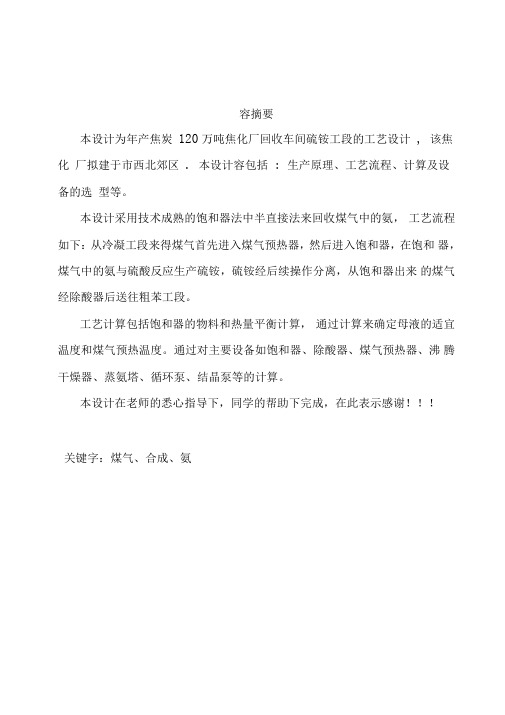
容摘要本设计为年产焦炭120万吨焦化厂回收车间硫铵工段的工艺设计, 该焦化厂拟建于市西北郊区. 本设计容包括: 生产原理、工艺流程、计算及设备的选型等。
本设计采用技术成熟的饱和器法中半直接法来回收煤气中的氨,工艺流程如下:从冷凝工段来得煤气首先进入煤气预热器,然后进入饱和器,在饱和器,煤气中的氨与硫酸反应生产硫铵,硫铵经后续操作分离,从饱和器出来的煤气经除酸器后送往粗苯工段。
工艺计算包括饱和器的物料和热量平衡计算,通过计算来确定母液的适宜温度和煤气预热温度。
通过对主要设备如饱和器、除酸器、煤气预热器、沸腾干燥器、蒸氨塔、循环泵、结晶泵等的计算。
本设计在老师的悉心指导下,同学的帮助下完成,在此表示感谢!!!关键字:煤气、合成、氨目录0 设计任务书⋯⋯⋯⋯⋯⋯⋯⋯⋯⋯⋯⋯⋯⋯⋯⋯⋯⋯⋯⋯⋯⋯⋯⋯⋯ 10.1 设计任务⋯⋯⋯⋯⋯⋯⋯⋯⋯⋯⋯⋯⋯⋯⋯⋯⋯⋯⋯⋯⋯⋯⋯⋯ 11 绪论⋯⋯⋯⋯⋯⋯⋯⋯⋯⋯⋯⋯⋯⋯⋯⋯⋯⋯⋯⋯⋯⋯⋯⋯⋯⋯⋯⋯ 21.1我国焦炭行业现状及发展⋯⋯⋯⋯⋯⋯⋯⋯⋯⋯⋯⋯⋯⋯⋯⋯⋯ 22 硫酸铵的用途及生产方法⋯⋯⋯⋯⋯⋯⋯⋯⋯⋯⋯⋯⋯⋯⋯⋯⋯⋯⋯ 32.1硫酸铵的生产方法⋯⋯⋯⋯⋯⋯⋯⋯⋯⋯⋯⋯⋯⋯⋯⋯⋯⋯⋯⋯43硫酸铵的生产原理和工艺流程⋯⋯⋯⋯⋯⋯⋯⋯⋯⋯⋯⋯⋯⋯⋯⋯⋯⋯53.1硫酸铵的生产原理⋯⋯⋯⋯⋯⋯⋯⋯⋯⋯⋯⋯⋯⋯⋯⋯⋯⋯⋯⋯⋯53.1.1硫酸铵生产的化学原理⋯⋯⋯⋯⋯⋯⋯⋯⋯⋯⋯⋯⋯⋯⋯⋯⋯ 53.1.2硫酸铵生产的结晶原理⋯⋯⋯⋯⋯⋯⋯⋯⋯⋯⋯⋯⋯⋯⋯⋯⋯ 63.2硫酸铵结晶的影响因素及控制⋯⋯⋯⋯⋯⋯⋯⋯⋯⋯⋯⋯⋯⋯⋯⋯73.2.1母液酸度对硫酸铵结晶的影响⋯⋯⋯⋯⋯⋯⋯⋯⋯⋯⋯⋯⋯⋯73.2.2温度和浓度对硫酸铵结晶的影响3.2.3母液的搅拌对硫酸铵结晶的影响3.2.4晶比对硫酸铵结晶的影响⋯⋯⋯⋯⋯⋯⋯⋯⋯⋯⋯⋯⋯⋯⋯⋯83.2.5杂志对硫酸铵结晶的影响⋯⋯⋯⋯⋯⋯⋯⋯⋯⋯⋯⋯⋯⋯⋯⋯83.3喷淋式饱和器法生产的工艺流程⋯⋯⋯⋯⋯⋯⋯⋯⋯⋯⋯⋯⋯⋯⋯94工艺计算与主要设备的选型⋯⋯⋯⋯⋯⋯⋯⋯⋯⋯⋯⋯⋯⋯⋯⋯⋯⋯104.1基础数据的计算⋯⋯⋯⋯⋯⋯⋯⋯⋯⋯⋯⋯⋯⋯⋯⋯⋯⋯⋯⋯⋯104.1.1装煤量的计算⋯⋯⋯⋯⋯⋯⋯⋯⋯⋯⋯⋯⋯⋯⋯⋯⋯⋯⋯⋯⋯10 4.1.2煤气发生量Q⋯⋯⋯⋯⋯⋯⋯⋯⋯⋯⋯⋯⋯⋯⋯⋯⋯⋯⋯⋯⋯10 4.1.3剩余氨水的计算⋯⋯⋯⋯⋯⋯⋯⋯⋯⋯⋯⋯⋯⋯⋯⋯⋯⋯⋯⋯11 4.2饱和器的有关计算及选型⋯⋯⋯⋯⋯⋯⋯⋯⋯⋯⋯⋯⋯⋯⋯⋯⋯114.2.1原始数据⋯⋯⋯⋯⋯⋯⋯⋯⋯⋯⋯⋯⋯⋯⋯⋯⋯⋯⋯⋯⋯⋯⋯11 4.2.2氨平衡及硫酸用量的计算⋯⋯⋯⋯⋯⋯⋯⋯⋯⋯⋯⋯⋯⋯⋯⋯12 4.2.3水平衡及母液温度的确定⋯⋯⋯⋯⋯⋯⋯⋯⋯⋯⋯⋯⋯⋯⋯⋯13 4.2.4热平衡及煤气预热器出口温度的计算⋯⋯⋯⋯⋯⋯⋯⋯⋯⋯⋯15 4.2.4.1输入热量⋯⋯⋯⋯⋯⋯⋯⋯⋯⋯⋯⋯⋯⋯⋯⋯⋯⋯⋯⋯⋯16 4.2.4.2输出热量⋯⋯⋯⋯⋯⋯⋯⋯⋯⋯⋯⋯⋯⋯⋯⋯⋯⋯⋯⋯⋯19 4.2.5饱和器基本尺寸⋯⋯⋯⋯⋯⋯⋯⋯⋯⋯⋯⋯⋯⋯⋯⋯⋯⋯⋯⋯20 4.3除酸器的计算及选型⋯⋯⋯⋯⋯⋯⋯⋯⋯⋯⋯⋯⋯⋯⋯⋯⋯⋯⋯20 4.3.1煤气进口尺寸⋯⋯⋯⋯⋯⋯⋯⋯⋯⋯⋯⋯⋯⋯⋯⋯⋯⋯⋯⋯⋯20 4.3.2煤气出口直径⋯⋯⋯⋯⋯⋯⋯⋯⋯⋯⋯⋯⋯⋯⋯⋯⋯⋯⋯⋯⋯21 4.3.3除算器径⋯⋯⋯⋯⋯⋯⋯⋯⋯⋯⋯⋯⋯⋯⋯⋯⋯⋯⋯⋯⋯⋯21 4.3.4出口管部分的高度⋯⋯⋯⋯⋯⋯⋯⋯⋯⋯⋯⋯⋯⋯⋯⋯⋯⋯214.4离心机的计算与选型⋯⋯⋯⋯⋯⋯⋯⋯⋯⋯⋯⋯⋯⋯⋯⋯⋯⋯⋯224.5沸腾床干燥器的计算与选型⋯⋯⋯⋯⋯⋯⋯⋯⋯⋯⋯⋯⋯⋯⋯⋯234.5.1原始数据⋯⋯⋯⋯⋯⋯⋯⋯⋯⋯⋯⋯⋯⋯⋯⋯⋯⋯⋯⋯⋯⋯234.5.2沸腾床最低流态速度G的计算⋯⋯⋯⋯⋯⋯⋯⋯⋯⋯⋯⋯⋯⋯234.5.3干燥器直径的确定与选型⋯⋯⋯⋯⋯⋯⋯⋯⋯⋯⋯⋯⋯⋯⋯⋯244.6煤气预热器的计算与选型⋯⋯⋯⋯⋯⋯⋯⋯⋯⋯⋯⋯⋯⋯⋯⋯⋯254.6.1热量恒算⋯⋯⋯⋯⋯⋯⋯⋯⋯⋯⋯⋯⋯⋯⋯⋯⋯⋯⋯⋯⋯⋯⋯254.6.1.1输入热量⋯⋯⋯⋯⋯⋯⋯⋯⋯⋯⋯⋯⋯⋯⋯⋯⋯⋯⋯⋯⋯264.6.1.2输出热量⋯⋯⋯⋯⋯⋯⋯⋯⋯⋯⋯⋯⋯⋯⋯⋯⋯⋯⋯⋯⋯264.6.2预热器选型⋯⋯⋯⋯⋯⋯⋯⋯⋯⋯⋯⋯⋯⋯⋯⋯⋯⋯⋯⋯⋯⋯274.7蒸氨塔及附属设备的计算⋯⋯⋯⋯⋯⋯⋯⋯⋯⋯⋯⋯⋯⋯⋯⋯⋯284.7.1蒸氨塔的计算⋯⋯⋯⋯⋯⋯⋯⋯⋯⋯⋯⋯⋯⋯⋯⋯⋯⋯⋯⋯⋯284.7.1.1基本数据的确定⋯⋯⋯⋯⋯⋯⋯⋯⋯⋯⋯⋯⋯⋯⋯⋯⋯⋯284.7.2物料恒算⋯⋯⋯⋯⋯⋯⋯⋯⋯⋯⋯⋯⋯⋯⋯⋯⋯⋯⋯⋯⋯⋯⋯294.7.3蒸氨塔设备的计算⋯⋯⋯⋯⋯⋯⋯⋯⋯⋯⋯⋯⋯⋯⋯⋯⋯⋯⋯304.7.4氨分凝器⋯⋯⋯⋯⋯⋯⋯⋯⋯⋯⋯⋯⋯⋯⋯⋯⋯⋯⋯⋯⋯⋯⋯324.7.5氨水换热器⋯⋯⋯⋯⋯⋯⋯⋯⋯⋯⋯⋯⋯⋯⋯⋯⋯⋯⋯⋯⋯⋯333.8干燥系统有关设备的选型与计算⋯⋯⋯⋯⋯⋯⋯⋯⋯⋯⋯⋯⋯⋯344.8.1旋风分离器的计算与选型⋯⋯⋯⋯⋯⋯⋯⋯⋯⋯⋯⋯⋯⋯⋯⋯344.8.2引风机的选型与计算⋯⋯⋯⋯⋯⋯⋯⋯⋯⋯⋯⋯⋯⋯⋯⋯⋯⋯354.9其他设备⋯⋯⋯⋯⋯⋯⋯⋯⋯⋯⋯⋯⋯⋯⋯⋯⋯⋯⋯⋯⋯⋯⋯⋯364.9.1结晶槽⋯⋯⋯⋯⋯⋯⋯⋯⋯⋯⋯⋯⋯⋯⋯⋯⋯⋯⋯⋯⋯⋯⋯⋯364.9.2硫铵高位槽⋯⋯⋯⋯⋯⋯⋯⋯⋯⋯⋯⋯⋯⋯⋯⋯⋯⋯⋯⋯⋯⋯364.9.3废氨水槽⋯⋯⋯⋯⋯⋯⋯⋯⋯⋯⋯⋯⋯⋯⋯⋯⋯⋯⋯⋯⋯⋯⋯364.9.4母液槽⋯⋯⋯⋯⋯⋯⋯⋯⋯⋯⋯⋯⋯⋯⋯⋯⋯⋯⋯⋯⋯⋯⋯⋯364.9.5泵的选型⋯⋯⋯⋯⋯⋯⋯⋯⋯⋯⋯⋯⋯⋯⋯⋯⋯⋯⋯⋯⋯⋯⋯375 硫铵工段设备一览表⋯⋯⋯⋯⋯⋯⋯⋯⋯⋯⋯⋯⋯⋯⋯⋯⋯⋯⋯⋯⋯56参考文献⋯⋯⋯⋯⋯⋯⋯⋯⋯⋯⋯⋯⋯⋯⋯⋯⋯⋯⋯⋯⋯⋯⋯⋯⋯⋯⋯59致谢⋯⋯⋯⋯⋯⋯⋯⋯⋯⋯⋯⋯⋯⋯⋯⋯⋯⋯⋯⋯⋯⋯⋯⋯⋯⋯⋯⋯⋯601绪论煤炭作为我国的主要能源之一,由于其储藏量有限,单纯作为燃料不仅浪费很大,而且会造成严重的环境污染,随着现代科技和化学工业的发展对煤炭的利用围已大大扩展,煤炭的综合利用已被列为我国煤炭行业的三大支柱。
硫铵

第三章硫铵工段1、岗位职责1.1 在化产班长领导下,完成其分配的作业任务1.2 严格执行本岗位操作规程,执行公司、部门及化产工段的相关技术、管理制度,确保人身、设备安全和产品质量稳定。
1.3 负责对各种工艺数据如实记录,并服从车间或调度室的工作安排。
1.4负责本岗位管辖设备、机泵、管道、阀门及电器仪表的安全运行和维护保养。
1.5 负责各备用设备的维护保养,保证各备用设备可以随时投入生产运行。
1.6 负责调整各运行设备、机泵的作业,使之控制在最佳的工艺运行状态,控制各工艺参数符合技术规定要求。
1.7 操作人员负责硫酸的接、送作业。
1.8 负责完成各项经济技术指标,确保生产安全稳定,生产出符合国家质量标准的硫铵。
1.9 负责在《硫铵记录报表》上填写工艺技术参数,在《生产作业交接班记录》上填写生产记录,在《设备巡回检查记录》上填写设备巡检及加油记录。
2、工艺流程原理2.1工艺流程由脱硫装置来的煤气进入喷淋式硫铵饱和器。
煤气在饱和器的上段分两股进入环形室,与循环母液逆流接触,其中的氨被母液中的硫酸吸收,生成硫酸铵。
脱氨后的煤气在饱和器的后室合并成一股,经小母液循环泵连续喷洒洗涤后,沿切线方向进入饱和器内旋风式除酸器,分出煤气中所夹带的酸雾后,送至终冷洗苯装置。
饱和器下段上部的母液经大母液循环泵连续抽出送至饱和器上段环形喷洒室循环喷洒,喷洒后的循环母液经中心降液管流至饱和器的下段。
在饱和器的下段,晶核通过饱和介质向上运动,使晶体长大,并引起晶粒分级。
当饱和器下段硫铵母液中晶比达到25%-40%(V%)时,用结晶泵将其底部的浆液抽送至室内结晶槽。
饱和器满流口溢出的母液自流至满流槽,再用小母液循环泵连续抽送至饱和器的后室循环喷洒,以进一步脱出煤气中的氨。
饱和器定期加酸加水冲洗时,多余母液经满流槽满流到母液贮槽;加酸加水冲洗完毕后,再用小母液循环泵逐渐抽出,回补到饱和器系统。
当饱和器母液系统水不平衡(水分过剩)时,可通过母液加热器对循环母液进行加热调整。
焦化厂的硫铵工段的流程

焦化厂的硫铵工段的流程## Englsih Answer:## Coke Oven Plant Ammonium Sulfate Process.The ammonium sulfate process in a coke oven plant is a crucial step in the recovery of valuable byproducts from the coking process. It involves the conversion of ammonia and sulfur dioxide gases into ammonium sulfate, which is a widely used fertilizer. The process consists of several stages, each designed to efficiently capture and convert these gases into a salable product.### 1. Ammonia Recovery.During the coking process, ammonia is released as a byproduct. To capture this ammonia, the coke oven gas is cooled and passed through a series of scrubbers. These scrubbers use water or weak sulfuric acid solutions to absorb the ammonia. The resulting solution is then sent toan ammonia still, where the ammonia is separated from the water or sulfuric acid through distillation.### 2. Sulfur Dioxide Recovery.Sulfur dioxide is another byproduct of the coking process. It is captured by passing the coke oven gas through sulfur scrubbers. These scrubbers use a solution of sodium hydroxide to absorb the sulfur dioxide, forming sodium sulfite and bisulfite.### 3. Ammonium Sulfate Formation.The recovered ammonia and sulfur dioxide gases are then reacted together in a saturator. In the saturator, the ammonia reacts with sulfuric acid to form ammonium sulfate. The reaction is exothermic, releasing a significant amount of heat.### 4. Crystallization and Drying.The ammonium sulfate solution produced in the saturatoris concentrated by evaporation. The concentrated solutionis then cooled, causing the ammonium sulfate to crystallize. The crystals are separated from the solution by centrifugation. The wet crystals are then dried in a rotary dryer to remove any remaining moisture.### 5. Packaging and Storage.The dried ammonium sulfate crystals are packaged inbags or bulk containers for storage and transportation.This fertilizer is widely used in agriculture to provide nitrogen and sulfur for plant growth.### Chinese Answer:## 焦化厂硫铵工段流程。
化产回收硫铵工段讲稿(1)
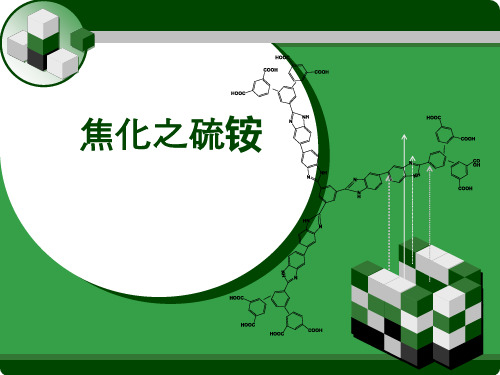
返回本级目录
金达煤化工科技有限公司
4.4 主要设备
喷淋式饱和器
离心机
喷淋式饱和器是硫铵工段的 主体设备,其结构示意见图。全 部采用耐酸不锈钢制作,无衬里。 有如下主要特点:
饱饱和和器器的上下部部为为吸结收晶室室,,由吸本 收体室、以外中套心筒降和液内管套与筒结组晶成室,连外通套, 循筒环与母内液套通筒过构降成液旋管风从分结离晶器室。的在 底煤部气向入上口返和,煤不气断出生口成间硫分酸隔铵成晶两 体个,弧穿形过分向配上箱运,动在的箱悬内浮配硫置酸喷铵嘴, 母喷液嘴,的促方使向晶均体朝长向大煤,气并流引,起形颗成 粒良分好级的。气流接触面。
一般宜将结晶层厚度(又称“垫层”)控制在结晶槽 高度的1/3。
返回本级目录
金达煤化工科技有限公司
4.7 操作要点
7.离心分离和水洗
离心分离和水洗效果对硫酸铵的游离酸含量和水分含量影响 很大。要求放入离心机的料浆流量和料浆的结晶含量保持稳定, 否则离心机转股内料层的厚度很难均匀,影响分离效果。
返回
金贵达州煤黔化桂工天能科焦技化有有限限公公司司
4.6 控制因素
母液酸度 母液温度 母液搅拌 晶比控制 杂质影响
母液中含可溶性和不溶性 杂质,杂质的种类和含量,取 决于生产工艺流程、硫酸质量、 工业用水质量、设备腐蚀情况 及操作条件等。母液中可溶性 杂质主要有铁、铝、铜、铅、 砷等各种盐类,多半来自硫酸、 设备腐蚀、工业用水,其离子 吸附在晶体表面,使晶体成长 缓慢。
返回本级目录
金贵达州煤黔化桂工天能科焦技化有有限限公公司司
4.7 操作要点
3.母液酸度和加酸制度
硫铵工段操作酸度控制在3.5%到4.5%左右。
酸度 控制
加酸制度
硫铵工段工艺论证

第一章绪论一、我国焦化行业的现状及发展炼焦化学产品在国民经济中占有重要的地位,炼焦化学工业是国民经济的一个重要部门,是钢铁联合企业的主要组成部分之一,是煤炭的综合利用工业。
煤在炼焦时,除有75% 左右变成焦炭外,还有25%左右生成多种化学产品及煤气。
在高温炼焦过程中,炼焦煤中所含的氮有10%~12%转变为氮气,约60%残留于焦炭中,有15%~20%生成氨,有1.2%~1.5%转变为毗啶盐基。
所生成的氨与赤热的焦炭反应则生成氰化氢。
2004年以后,中国焦化行业出现一些新特点:中国焦化行业显现新特点——焦炭产能急剧膨胀,产量过剩若隐若现这是因为:一方面,部分焦炭项目仍处于建设阶段,还不能形成实际的焦炭产量;同时,由于国家在2004年底出台了新的焦化行业准入标准,一大批落后的焦炭产能将被淘汰。
这使得焦炭产量过剩始终是若隐若现。
中国焦炭供给和需求大致呈现总体平衡、略有富余的态势。
——炼焦煤资源充足,但价格上升幅度较大凭借相对丰富的炼焦煤资源,我国还是有能力保证焦炭生产的原料煤供应。
不过,由于产业结构的原因,相对零散且缺乏资源保障的中国焦化行业,不得不接受炼焦原料煤价格日益上涨的现实。
——焦化行业整合时代即将来临很长一段时间以来,企业规模过小、产业零散问题一直困扰着中国焦化行业的发展。
在 2002年以前,产能100万吨以上的独立焦化企业只有寥寥数家。
经过近几年的民展,中国独立焦化企业平均产能规模有所扩大,出现了一批超过200万吨的大型独立焦化企业。
预计随着市场竞争的加剧,焦化行业优胜劣汰的局面将会出现,产业集中化趋势将日益明显,大型国际化焦化企业集团即将形成。
随着焦炭行业的迅速发展,存在的问题也日益显现。
首要问题是产能严重过剩。
自2002 年以来,由于全球钢铁业的快速发展,焦炭出现了供应紧张的局面,国内外焦炭价格上涨迅猛。
鉴于此种状况,各国为了降低对我国焦炭的依存度,纷纷恢复、改扩建焦炉,2005年至2006年,全球焦炭产能将新增8000万吨,其中我国新增5800万吨、巴西660万吨、德国290万吨、印度280万吨、美国270万吨、波兰220万吨,2005年国际焦炭产能将超过 4.5亿吨。
MineSafety煤矿安全大学毕业论文英文文献翻译及原文

毕业设计(论文)外文文献翻译文献、资料中文题目:煤矿安全文献、资料英文题目:Mine safety文献、资料来源:文献、资料发表(出版)日期:院(部):专业:班级:姓名:学号:指导教师:翻译日期: 2017.02.14附录:外文资料与中文翻译外文资料:Mine safetyCoal mining historically has been a hazardous occupation but, in recent years, tremendous progress has been made in reducing accidental coal mine deaths and injuries.the main aspect is as following:⑴ Safety of mine ventilation•Purposes of Mine Ventilation•Properly engineered control of the mine atmosphere is required to: •provide fresh air (oxygen) for men to breathe•provide a source of oxygen for internal combustion engines in machinery •dilute atmospheric contaminants to acceptable levels•maintain temperature and humidity within acceptable limits•remove atmospheric contaminants from the mine.Mine ventilation is twofold in purpose: first, it maintains life, and secondly it carries off dangerous gases. The historic role of ventilation was to provide a flow of fresh air sufficient to replace the oxygen consumed by the miners working underground. Today's mine ventilation primarily deals with noxious gases (mainly generated by trackless equipment underground).Canaries are said to have been used to detect gas in coal mines in the earlystages of coal mining. This sensitive bird would be taken into the workings and, if it perished, the colliers would immediately leave the mine.In the 1920s the hand-turned fans were replaced with air-powered small turbine fans. Large fans of the suction type were placed on the surface and gradually increased in size. Air from surface compressors was piped into the mine to power machinery and to assist in ventilation.Unless the air is properly distributed to the face, the mine ventilation system is not performing its primary function [1]. While it has always been recognized that this last part of ventilation is the most import, it is also the most difficult to achieve.The primary means of producing and controlling the airflow are also illustrated on Figure 1. Main fans, either singly or in combination, handle all of the air that passesthrough the entire system.These are usually, but notnecessarily, located onsurface, either exhaustingair through the system asshown on Figure 1 or,alternatively, connected todowncast shafts or mainintakes and forcing air into and through the system. Because of the additional hazards of gases and dust that may both be explosive, legislation governing the ventilation of coal mines is stricter than for most other underground facilities. In many countries, the main ventilation fans for coal minesare Figure 1. Typical elements of a main ventilation systemrequired, by law, to be placed on surface and may also be subject to other restrictions such as being located out of line with the connected shaft or drift and equipped with "blow-out" panels to help protect the fan in case of a mine explosion.Stoppings and Seals:In developing a mine, connections are necessarily made between intakes and returns. When these are no longer required for access or ventilation, they should be blocked by stoppings in order to prevent short-circuiting of the airflow. Stoppings can be constructed from masonry, concrete blocks or fireproofed timber blocks. Prefabricated steel stoppings may also be employed. Stoppings should be well keyed into the roof, floor and sides, particularly if the strata are weak or in coal mines liable to spontaneous combustion. Leakage can be reduced by coating the high pressure face of the stopping with a sealant material and particular attention paid to the perimeter. Here again, in weak or chemically active strata, such coatings may be extended to the rock surfaces for a few metres back from the stopping. In cases where the airways are liable to convergence, precautions should be taken to protect stoppings against premature failure or cracking. These measures can vary from "crush pads" located at the top of the stopping to sliding or deformable panels on prefabricated stoppings. In all cases, components of stoppings should be fireproof and should not produce toxic fumes when heated.As a short term measure, fire-resistant brattice curtains may be tacked to roof, sides and floor to provide temporary stoppings where pressure differentials are low such as in locations close to the working areas.Where abandoned areas of a mine are to be isolated from the currentventilation infrastructure, seals should be constructed at the entrances of the connecting airways. If required to be explosion-proof, these consist of two or more stoppings, 5 to 10 metres apart, with the intervening space occupied by sand, stone dust, compacted non-flammable rock waste, cement-based fill or other manufactured material. Steel girders, laced between roof and floor add structural strength. Grouting the surrounding strata adds to the integrity of the seal in weak ground. In coal mines, mining law or prudent regard for safety may require seals to be explosion-proof.Doors and airlocks:Where access must remain available between an intake and a return airway, a stopping may be fitted with a ventilation door. In its simplest form, this is merely a wooden or steel door hinged such that it opens towards the higher air pressure. This self-closing feature is supplemented by angling the hinges so that the door lifts slightly when opened and closes under its own weight. It is also advisable to fit doors with latches to prevent their opening in cases of emergency when the direction of pressure differentials may be reversed. Contoured flexible strips attached along the bottom of the door assist in reducing leakage, particularly when the airway is fitted with rail track.Ventilation doors located between main intakes and returns are usually built as a set of two or more to form an airlock. This prevents short-circuiting when one door is opened for passage of vehicles or personnel. The distance between doors should be capable of accommodating the longest train of vehicles required to pass through the airlock. For higher pressure differentials, multiple doors also allow the pressure break to be shared between doors. Mechanized doors, opened by pneumatic or electrical means are particularlyconvenient for the passage of vehicular traffic or where the size of the door or air pressure would make manual operation difficult. Mechanically operated doors may, again, be side-hinged or take the form of rollup or concertina devices. They may be activated manually by a pull-rope or automatic sensing of an approaching vehicle or person. Large doors may be fitted with smaller hinged openings for access by personnel. Man-doors exposed to the higher pressure differentials may be difficult to open manually. In such cases, a sliding panel may be fitted in order to reduce that pressure differential temporarily while the door is opened. Interlock devices can also be employed on an airlock to prevent all doors from being opened simultaneously.Cfd applied to ventilation sys tems:Due to recent advances in computer processing power CFD has been used to solve a wide range of large and complex flow problems across many branches of engineering (Moloney et. al. 1997/98/99). The increase in processor speed has also enabled the development of improved post processing and graphical techniques with which to visualize the results produced by these models. Recent research work has employed CFD models, validated by scale and full-scale experiments, to represent the ventilation flows and pollutant dispersion patterns within underground mine networks. In particular, studies by Moloney (1997) demonstrated that validated CFD models were able to successfully replicate the ventilation flows and gaseous pollutant dispersion patterns observed within auxiliary ventilated rapid development drivages. CFD has proven a capable method by which to identify detailed characteristics of the flow within critical areas such as the cutting face. The results produced by the CFD models were able to demonstrate the relativeefficiency of the different auxiliary ventilation configurations in the dilution, dispersion and transport of the methane and dust from the development face. Further recent studies by Moloney et. al. (1999) have demonstrated that such validated CFD models may be used to simulate the airflow and pollutant dispersion data for a wide range of mining and ventilation configurations. Each simulation exercise produces large sets of velocity, pressure and pollutant concentration data.⑵ Fires Methods of ControlFires that occur in mine airways usually commence from a single point of ignition. The initial fire is often quite small and, indeed, most fires are extinguished rapidly by prompt local action. Speed is of the essence. An energetic ignition that remains undetected, even for only a few minutes, can develop into a conflagration that becomes difficult or impossible to deal with. Sealing off the district or mine may then become inevitable.The majority of fires can be extinguished quickly if prompt action is taken. This underlines the importance of fire detection systems, training, a well-designed firefighting system and the ready availability of fully operational firefighting equipment. Fire extinguishers of an appropriate type should be available on vehicles and on the upstream side of all zones of increased fire hazard. These include storage areas and fixed locations of equipment such as electrical or compressor stations and conveyor gearheads. Neither water nor foam should be used where electricity is involved until it is certain that the power has been switched off. Fire extinguishers that employ carbon dioxide or dry powders are suitable for electrical fires or those involving flammable liquids.Deluge and sprinkler systems can be very effective in areas of fixed equipment, stores and over conveyors. These should be activated by thermal sensors rather than smoke or gas detectors in order to ensure that they are operated only when open combustion occurs in the near vicinity.Except where electricity or flammable liquids are involved, water is the most common medium of firefighting. When applied to a burning surface, water helps to remove two sides of the fire triangle. The latent heat of the water as it vapourises and the subsequent thermal capacity of the water vapour assist in removing heat from the burning material. Furthermore, the displacement of air by water vapour and the liquid coating on cooler surfaces help to isolate oxygen from the fire.⑶ Methods of Dust ControlThe three major control methods used to reduce airborne dust in tunnels and underground mines: ventilation, water, and dust collectors.Ventilation air reduces dust through both dilution and displacement. The dilution mechanism operates when workers are surrounded by a dust cloud and additional air serves to reduce the dust concentration by diluting the cloud. The displacement mechanism operates when workers are upwind of dust sources and the air velocity is high enough to reliably keep the dust downwind.① Dilution Ventilation. The basic principle behind dilution ventilation is to provide more air and dilute the dust. Most of the time the dust is reduced roughly in proportion to the increase in airflow, but not always. The cost of and technical barriers to increased airflow can be substantial, particularly where air already moves through ventilation ductwork or shafts at velocitiesof 3,000 ft/min or more.②Displacement Ventilation. The basic principle behind displacement ventilation is to use the airflow in a way that confines the dust source and keeps it away from workers by putting dust downwind of the workers. Every tunnel or mine passage with an airflow direction that puts dust downwind of workers uses displacement ventilation. In mines, continuous miner faces or tunnel boring machines on exhaust ventilation use displacement ventilation. Enclosure of a dust source, such as a conveyor belt transfer point, along with extraction of dusty air from the enclosure, is another example of displacement ventilation. Displacement ventilation can be hard to implement. However, if done well, it is the most effective dust control technique available, and it is worth considerable effort to get it right. The difficulty is that when workers are near a dust source, say, 10 to 20 ft from the source, keeping them upwind requires a substantial air velocity, typically between 60 and 150 ft/min. There is not always enough air available to achieve these velocities.③ Water sprays. The role of water sprays in mining is a dual one: wetting of the broken material being transported and,airborne capture. Of the two, wetting of the broken material is far more effective.Adequate wetting is extremely important for dust control. The vast majority of dust particles created during breakage are not released into the air, but stay attached to the surface of the broken material. Wetting this broken material ensures that the dust particles stay attached. As a result, adding more water can usually (but not always) be counted on to reduce dust. For example, coal mine operators have been able to reduce the dust from higher longwallproduction levels by raising the shearer water flow rate to an average of 100gpm. Compared to the amount of coal mined, on a weight basis, this 100gpm is equivalent to 1.9% added moisture from the shearer alone. Unfortunately, excessive moisture levels can also result in a host of materials handling problems, operational headaches, and product quality issues, so an upper limit on water use is sometimes reached rather quickly. As a result, an alternative to simply adding more water is to ensure that the broken material is being wetted uniformly.⑷ Mine DrainageWater invades almost every mine in the form of :direct precipitation (rain and snow), surface runoff, underground percolation. Flows of water have an important effect on the cost and progress of many mining operations and present life and property hazards in some cases.Means of Mine-water Control(Mine Drainage):As shafts and other mine openings extend below the water table, water is likely to be encountered and to seep into the openings to an extent depending upon the area of rock surface exposed, the hydrostatic pressure, and other factors. In order to continue mining operations, it is therefore necessary to lower the ground water level in the vicinity of the mine by artificial means to keep the workings free of water as well as preventing the flow of surface water into the (surface or underground) mine. This operation is known as mine drainage.Means of mine drainage are limited by circumstances and objectives. The following types of mine-water control can be used singly or more effectively in combination:① Locate shafts or excavations in best ground and protect from direct water inflow from surfaces.② Divert or drain water at or near surface.③Reduce permeability of rock mass by grouting with special types of cement, bentonite and liquid chemical grouts (water sealing).④ Case or cement exploration drill holes.⑤Drill pilot holes in advance of work wherever there may be sudden influents at rates potentially inconvenient.⑥Dewater bedrock at depth by pumping through dewatering wells or from an accessible place in the mine.。
硫铵工段的设备改造
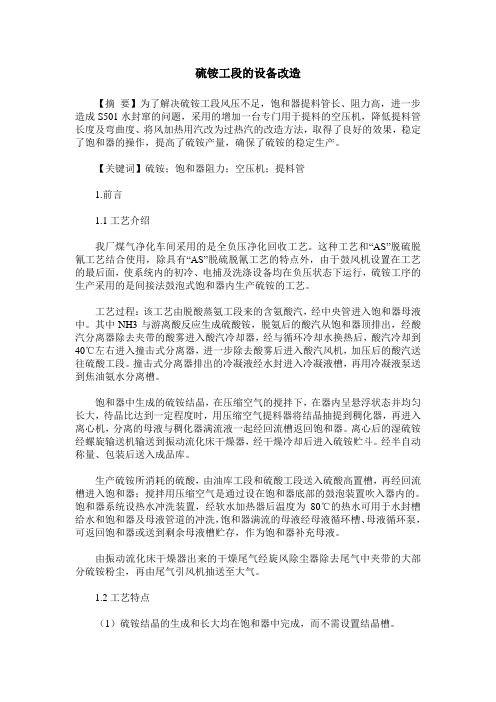
硫铵工段的设备改造【摘要】为了解决硫铵工段风压不足,饱和器提料管长、阻力高,进一步造成S501水封窜的问题,采用的增加一台专门用于提料的空压机,降低提料管长度及弯曲度、将风加热用汽改为过热汽的改造方法,取得了良好的效果,稳定了饱和器的操作,提高了硫铵产量,确保了硫铵的稳定生产。
【关键词】硫铵;饱和器阻力;空压机;提料管1.前言1.1工艺介绍我厂煤气净化车间采用的是全负压净化回收工艺。
这种工艺和“AS”脱硫脱氰工艺结合使用,除具有“AS”脱硫脱氰工艺的特点外,由于鼓风机设置在工艺的最后面,使系统内的初冷、电捕及洗涤设备均在负压状态下运行,硫铵工序的生产采用的是间接法鼓泡式饱和器内生产硫铵的工艺。
工艺过程:该工艺由脱酸蒸氨工段来的含氨酸汽,经中央管进入饱和器母液中。
其中NH3与游离酸反应生成硫酸铵,脱氨后的酸汽从饱和器顶排出,经酸汽分离器除去夹带的酸雾进入酸汽冷却器,经与循环冷却水换热后,酸汽冷却到40℃左右进入撞击式分离器,进一步除去酸雾后进入酸汽风机,加压后的酸汽送往硫酸工段。
撞击式分离器排出的冷凝液经水封进入冷凝液槽,再用冷凝液泵送到焦油氨水分离槽。
饱和器中生成的硫铵结晶,在压缩空气的搅拌下,在器内呈悬浮状态并均匀长大,待晶比达到一定程度时,用压缩空气提料器将结晶抽提到稠化器,再进入离心机,分离的母液与稠化器满流液一起经回流槽返回饱和器。
离心后的湿硫铵经螺旋输送机输送到振动流化床干燥器,经干燥冷却后进入硫铵贮斗。
经半自动称量、包装后送入成品库。
生产硫铵所消耗的硫酸,由油库工段和硫酸工段送入硫酸高置槽,再经回流槽进入饱和器;搅拌用压缩空气是通过设在饱和器底部的鼓泡装置吹入器内的。
饱和器系统设热水冲洗装置,经软水加热器后温度为80℃的热水可用于水封槽给水和饱和器及母液管道的冲洗,饱和器满流的母液经母液循环槽、母液循环泵,可返回饱和器或送到剩余母液槽贮存,作为饱和器补充母液。
由振动流化床干燥器出来的干燥尾气经旋风除尘器除去尾气中夹带的大部分硫铵粉尘,再由尾气引风机抽送至大气。
化产车间硫铵工艺流程

化产车间硫铵工艺流程英文回答:The ammonium sulfate production process in a chemical workshop involves several steps. Here, I will explain the process in detail.1. Raw material preparation: The first step is to prepare the raw materials required for the production of ammonium sulfate. The main raw materials include sulfuric acid and ammonia. These materials are usually stored in tanks or containers.2. Mixing and reaction: Once the raw materials are ready, they are mixed together in a reaction vessel. The sulfuric acid and ammonia react to form ammonium sulfate. This reaction is exothermic, meaning it releases heat. The temperature and pressure in the reaction vessel need to be controlled to ensure the reaction proceeds smoothly.3. Crystallization: After the reaction, the mixture is allowed to cool down. As it cools, the ammonium sulfate starts to crystallize. The crystals are then separated from the liquid using filtration or centrifugation. The separated crystals are washed to remove impurities and dried to obtain the final product.4. Packaging and storage: Once the ammonium sulfate crystals are dried, they are packaged in bags or containers for storage or transportation. The packaging is usually done in a separate area of the workshop to prevent contamination.It is important to note that the specific details of the ammonium sulfate production process may vary depending on the equipment and technology used in the workshop. The steps mentioned above are a general outline of the process.中文回答:化工车间中硫铵的生产工艺流程包括以下几个步骤。
合成氨工段工艺英文作文

合成氨工段工艺英文作文The synthesis of ammonia is a crucial industrialprocess with widespread applications in the fertilizer industry, among others. This complex process involves several stages, each designed to optimize the reaction conditions for the conversion of nitrogen and hydrogen into ammonia.The first stage of the process is the preparation ofthe feedstock, which consists mainly of nitrogen and hydrogen. Nitrogen is typically obtained from the air through a process called nitrogen separation, while hydrogen is often derived from natural gas or coal gasification. These gases are then purified to remove any impurities that could interfere with the synthesis reaction. The purified gases are then compressed and heated tothe appropriate reaction conditions. This step is crucialas it ensures that the gases are at a high enough pressure and temperature for the synthesis reaction to occur efficiently. The reaction is catalyzed by the use of iron-based catalysts, which lower the activation energy required for the reaction to proceed.Once the reaction conditions are met, the gases are passed over the catalyst bed, where the synthesis reaction takes place. This reaction is endothermic, meaning it absorbs heat, and it is also reversible, meaning it can proceed in both directions. To favor the formation of ammonia, the reaction is carried out at high pressures and temperatures, and the resulting ammonia is removed from the reaction mixture as it forms.The resulting ammonia is then separated from the unreacted gases and purified to remove any residual impurities. This purified ammonia is then ready for use in various applications, such as the production of fertilizers and other chemicals.The synthesis of ammonia is not only technically complex but also environmentally challenging. The process requires a significant amount of energy, and the by-products of the process can have adverse environmental effects. Therefore, ongoing research is focused on developing more efficient and environmentally friendly methods for synthesizing ammonia.In conclusion, the synthesis of ammonia is a crucial industrial process that requires meticulous attention to detail. The careful control of reaction conditions, the use of appropriate catalysts, and the purification of the feedstock and product are all essential for achieving high yields of pure ammonia. Despite the technical and environmental challenges, the widespread applications of ammonia make this process a vital part of modern industrial production.**合成氨工艺详解**合成氨是一项至关重要的工业过程,在肥料工业等领域有着广泛的应用。
年产70万吨焦化厂硫铵工段的初步设计毕业设计论文

I课程设计任务书注:1.课程设计完成后,学生提交的归档文件应按照:封面—任务书—说明书—图纸的顺序进行装订上交(大张图纸不必装订)2.可根据实际内容需要续表,但应保持原格式不变。
II指导教师签名:日期:III课程设计说明书目录课程设计任务书 (Ⅰ)一、绪论 (1)1、概述 (1)2、回收氨方法概述 (1)2.1、水洗氨法 (1)2.2、硫酸吸氨法 (1)2.3、磷酸吸氨法 (2)3、硫铵的生产方法 (2)3.1、直接法 (2)3.2、间接法 (2)3.3、半直接法 (2)二、化工技术部分 (3)1、硫铵工段流程简介 (3)2、饱和器的物料平衡和热平衡 (3)三、硫铵工段的设备计算及选型 (5)四、硫铵工段工艺布置 (20)五、对其他专业要求 (21)六、经济技术部分 (21)七、综合技术部分 (22)1、厂址选择 (22)2、外部条件 (24)八、硫铵工段设备一览表 (26)九、结束语 (27)十、主要参考资料 (28)一、绪论1、概述煤炭作为我国的主要能源之一,由于其储藏量有限,单纯作为燃料不仅浪费很大,而且会造成严重的环境污染,随着现代科技和化学工业的发展对煤炭的利用范围已大大扩展,煤炭的综合利用已被列为我国煤炭行业的三大支柱。
高温炼焦化学工业是煤炭的综合利用中历史最久,工业最完善,技术最成熟,应用最广泛的行业。
由于煤炭的自身组成特殊性,在炼焦同时产生的煤气中,含有多种可供回收利用的成分,其中氨作为生产过程中的有害成分之一,其含量虽少但由于其水溶液具有腐蚀设备和管路,生成的铵盐会引起堵塞,燃烧产生的氮氨化物污染大气,所以有必要将其回收,并加以利用。
硫铵的生产不仅达到了除去煤气中氨的目的,而且硫铵作为化肥应用于农业中可以提高农作物的单位面积产量,对农业的发展起着重要作用。
2、回收氨方法概述2.1、水洗氨法是以软水为吸收液回收煤气中的氨,同时使焦炉气得到净化。
回收的氨制成氮肥或进行分解。
这类方法有:制浓氨水法、间接法、联碱法和氨分解法。
如何写好中英文摘要

统的 H S 含量 。
4 结
语
某 公司 以焦炉煤 气为原料 生产 L N G过程 中 , 焦 炉 煤气精脱 硫工艺 采用催化加 氢转化法 , 进入 精脱硫 工 序 的焦 炉煤气 中所 含的 0 、 H 。 s 、 焦油 、 粉 尘等超
造成催 化剂高 温失活 、寿命 缩短及设 备堵 塞等危 害 , 因此 , 上述指 标必须严 格控制 ; 该工艺运行 稳定 , 可将 焦 炉煤 气 中总硫 体积 分数 脱 除至 0 . 1 ×1 0 以下 , 能 够满 足焦炉煤 气液化制 L N G 对 原料气 的要求 。
按 工艺 要求 , 精 脱硫 系统 平稳 运 行期 间 , 进 精脱 硫 系统 的焦 炉煤气 中萘 、 焦油 、 尘质量浓度控制指标分 别为≤1 0 m g / m 。 、 ≤5 m g / m 。 、 ≤3 m g / m 。 。若此 类 杂质进
an d I t s Pr od uc t i o n Pr a c t i c e
Wa n g Ai r o n g , Hu Xi a o , S h i J u n we i , Wa n g Ha i y a n g 2 a n d L e i Z h i y o n g
一
4 4
煤 化 工
2 0 1 6年 第 6期
H 2 s 质量浓度高达 7 0 0 m g / m 3  ̄ 8 0 0 m g / m 。 ) , 不 仅增加 了加 氢转 化器 的负担 ,缩短 了加 氢催化 剂 的使 用寿命 , 还 会 造成 Z n 0脱硫剂 过早 的出现硫容 饱和 , 使得 精脱硫 系统运行成 本大大增加 。因此 , 必 须控 制进精脱 硫系
年产36万吨合成氨脱硫工段工艺设计(毕业论文)(可编辑)
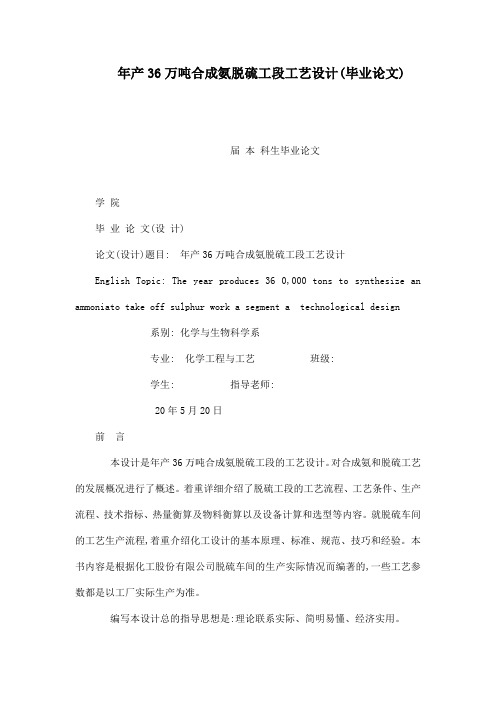
年产36万吨合成氨脱硫工段工艺设计(毕业论文)届本科生毕业论文学院毕业论文(设计)论文(设计)题目: 年产36万吨合成氨脱硫工段工艺设计English Topic: The year produces 36 0,000 tons to synthesize an ammoniato take off sulphur work a segment a technological design系别: 化学与生物科学系专业: 化学工程与工艺班级:学生: 指导老师:20年5月20日前言本设计是年产36万吨合成氨脱硫工段的工艺设计。
对合成氨和脱硫工艺的发展概况进行了概述。
着重详细介绍了脱硫工段的工艺流程、工艺条件、生产流程、技术指标、热量衡算及物料衡算以及设备计算和选型等内容。
就脱硫车间的工艺生产流程,着重介绍化工设计的基本原理、标准、规范、技巧和经验。
本书内容是根据化工股份有限公司脱硫车间的生产实际情况而编著的,一些工艺参数都是以工厂实际生产为准。
编写本设计总的指导思想是:理论联系实际、简明易懂、经济实用。
本书在编写过程中得到老师的指导,在此表示衷心感谢。
由于编者自身的知识水平和认识水平的有限,书中错误与不妥之处,恳请读者批评指正。
编者20年5月于目录前言2摘要5Abstract 61.总论71.1 概述71.1.1 栲胶的组成及性质81.1.2栲胶脱硫的反应机理81.1.3生产中副产品硫磺的应用91.2 文献综述91.3 设计任务的依据102. 流程方案的确定112.1 各脱硫方法对比112.2栲胶脱硫法的理论依据122.3 工艺流程方框图133. 生产流程的简述143.1 简述物料流程 143.1.1气体流程143.1.2溶液流程143.1.3硫磺回收流程143.2 工艺的化学过程143.3 反应条件对反应的影响153.3.1 影响栲胶溶液吸收的因素15 3.3.2 影响溶液再生的因素173.4 工艺条件的确定183.4.1 溶液的组成 183.4.2喷淋密度和液气比的控制18 3.4.3 温度193.4.4再生空气量194 物料衡算和热量衡算204.1 物料衡算204.2 热量衡算235 设备计算及选型 275.1 脱硫塔的设计计算275.1.1塔径计算275.1.2填料高度计算285.2 喷射再生槽的计算295.2.1 槽体计算295.2.2 喷射器计算 316. 车间布置说明347三废治理及利用357.1 废水的处理357.1.1废水的来源及特点357.1.2废水处理工艺357.2 废渣的处理357.2.1废渣的来源357.2.2废渣的处理工艺 35参考文献36附录37工艺流程图37脱硫塔装配图37车间平面布置图37致谢38年产36万吨合成氨脱硫工段工艺设计学生姓名:指导老师:摘要:年产36万吨合成氨脱硫工段工艺设计是由指导老师指定产量确定的生产规模,结合生产实习中收集的各类生产技术指标而设计的。
硫铵工段工艺详述
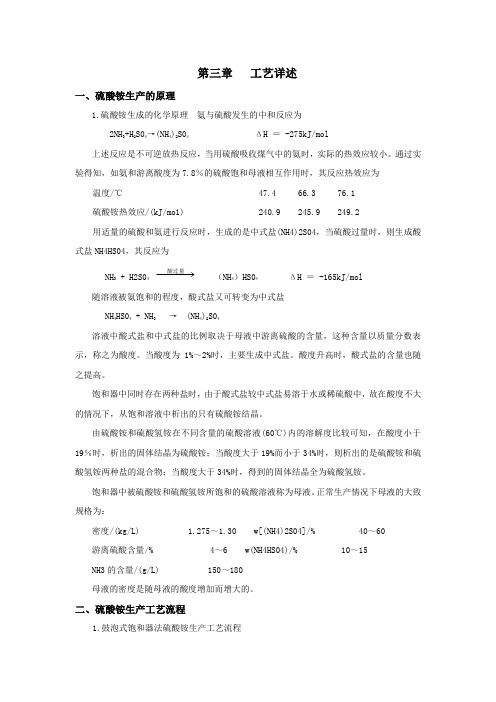
第三章 工艺详述一、硫酸铵生产的原理1.硫酸铵生成的化学原理 氨与硫酸发生的中和反应为2NH 3+H 2S04→(NH 4)2S04 ΔH = -275kJ/mol上述反应是不可逆放热反应,当用硫酸吸收煤气中的氨时,实际的热效应较小。
通过实验得知,如氨和游离酸度为7.8%的硫酸饱和母液相互作用时,其反应热效应为 温度/℃ 47.4 66.3 76.1硫酸铵热效应/(kJ/mo1) 240.9 245.9 249.2用适量的硫酸和氨进行反应时,生成的是中式盐(NH4)2S04,当硫酸过量时,则生成酸式盐NH4HS04,其反应为NH 3 + H2S04 −−−→酸过量(NH 4)HS04 ΔH = -165kJ/mol 随溶液被氨饱和的程度,酸式盐又可转变为中式盐NH 4HS04 + NH 3 → (NH 4)2S04溶液中酸式盐和中式盐的比例取决于母液中游离硫酸的含量,这种含量以质量分数表示,称之为酸度。
当酸度为1%~2%时,主要生成中式盐。
酸度升高时,酸式盐的含量也随之提高。
饱和器中同时存在两种盐时,由于酸式盐较中式盐易溶于水或稀硫酸中,故在酸度不大的情况下,从饱和溶液中析出的只有硫酸铵结晶。
由硫酸铵和硫酸氢铵在不同含量的硫酸溶液(60℃)内的溶解度比较可知,在酸度小于19%时,析出的固体结晶为硫酸铵;当酸度大于19%而小于34%时,则析出的是硫酸铵和硫酸氢铵两种盐的混合物;当酸度大于34%时,得到的固体结晶全为硫酸氢铵。
饱和器中被硫酸铵和硫酸氢铵所饱和的硫酸溶液称为母液。
正常生产情况下母液的大致规格为:密度/(kg/L) 1.275~1.30 w[(NH4)2S04]/% 40~60游离硫酸含量/% 4~6 w(NH4HS04)/% 10~15NH3的含量/(g/L) 150~180母液的密度是随母液的酸度增加而增大的。
二、硫酸铵生产工艺流程1.鼓泡式饱和器法硫酸铵生产工艺流程鼓泡式饱和器法硫酸铵生产工艺流程如图1所示。
80万吨冶金焦的焦化厂设立硫铵工段的工艺设计

80万吨冶金焦的焦化厂设立硫铵工段的工艺设计引言:焦炭硫铵工段是焦化厂生产硫铵产品的重要环节之一、硫铵是一种重要的氮肥,广泛应用于农业生产中。
本文将介绍一个80万吨冶金焦的焦化厂焦炭硫铵工段的工艺设计。
工艺流程:该工艺流程主要包括原料破碎、浸出、过滤、蒸发、结晶、分离、干燥、包装等环节。
具体流程如下:1.原料破碎:将冶金焦炭通过先进的破碎设备进行细碎,得到符合要求的颗粒状焦炭碎料。
2.浸出:将焦炭碎料放入浸出釜内,加入一定比例的反应剂(如稀硫酸等),进行浸出反应。
反应温度、时间和浸出剂的用量要根据具体研究确定。
3.过滤:将浸出后的溶液通过滤设备进行固液分离,得到硫铵的溶液。
4.蒸发:将硫铵溶液进行蒸发浓缩,提高溶液中硫铵的浓度。
蒸发过程需要控制温度和蒸发速度,以避免硫铵反应产生不良物质。
5.结晶:将浓缩后的硫铵溶液进行结晶处理,通过控制结晶条件,如温度、搅拌速度和结晶种子添加量等,可以得到高纯度、均匀大小的硫铵晶体。
6.分离:将硫铵晶体与溶液进行分离,可以采用离心机等设备进行分离,得到湿硫铵晶体。
7.干燥:将湿硫铵晶体进行干燥处理,使其含水量降低至符合要求的范围。
干燥温度和时间要根据具体产品质量要求来确定。
8.包装:将干燥后的硫铵产品进行包装,可以采用自动化包装线进行操作,确保产品的质量和安全。
设备配置:该工艺流程需要配备一系列的设备,包括破碎机、浸出釜、过滤设备、蒸发器、结晶器、离心机、干燥设备、包装线等。
这些设备的选择和配置要根据生产能力、产品质量要求、工艺效率等因素进行适当的选择。
控制要点:在硫铵工段的工艺设计中,控制是非常重要的一环。
主要包括以下几个方面:1.温度控制:在浸出、蒸发、结晶等环节中,控制适当的温度,确保反应和转化的效果。
2.时间控制:在蒸发、结晶等环节中,控制合理的时间,以保证产品的质量和产量。
3.搅拌控制:在结晶环节中,适当调节搅拌速度和时间,保证晶体大小和纯度的一致性。
硫铵工段

摘要本设计为15万m3/h焦炉煤气硫铵工段工艺设计,设计内容包括:生产原理、工艺流程、计算及设备的选型、工艺布置、操作规程。
硫铵工段采用技术成熟的饱和器法中半直接法来回收煤气中的氨,工艺流程如下:从冷凝工段来得煤气首先进入煤气预热器,然后进入饱和器,在饱和器内,煤气中的氨与硫酸反应生产硫铵,硫铵经后续操作分离,从饱和器出来的煤气经除酸器后送往粗苯工段。
本设计的任务是计算15万m3/h焦炉煤气硫铵工段,主要内容有:通过饱和器物料平衡、水平衡、热平衡的计算,以此来确定饱和器选用3台D=6250mm的饱和器,煤气预热器的计算及选型,旋风式除湿器的选择,沸腾干燥器型号的选择。
还制定了主要非工艺条件,绘制了硫铵工段的设备平面布置图。
最后,给出了图纸目录及具体的计算说明。
关键词:硫铵工段;饱和器;煤气预热AbstractThis design is 15 tons/h of coking oven gas ammonium section process design, this design contents :production principle, process flow, calculation and the equipment selection, process arrangement and operation procedures.Ammonium section of the semi direct method of mature technology in the saturator method to recover ammonia from the gas, the process is as follows: from the condensing section moregas first enters the gas heater, and then into the saturator in saturated reactor, reaction of ammonia and sulfuric acid production of ammonium sulfate in the gas, sulfur ammonium by subsequent operation separation from saturated reactor out of the gas by acid separator to crude benzol section.The task of this design is to compute the 150,000 m3/h coke oven gas ammonium section, the main contents are: calculated by saturated reactor material balance, water balance, heat balance,in order to determine the saturator selection three saturated reactors with D=6250mm ;calculation and selection of gas preheater; cyclone type dehumidifier choice; boiling dryertype selection. Also formulated the mainnon technological conditions, drawing equipment plane layout of the ammonium section.Finally, note gives drawings directory and specific calculation.Keywords:Ammonium sulfatesection ; Saturator ; Gas preheating目录1 绪论 (1)2 工艺流程选择 (2)2.1 硫酸铵的用途及生产方法 (2)2.2 生产工艺流程的原理 (3)2.3 硫铵的生产方法 (3)2.4 饱和器法生产硫铵的工艺流程 (4)2.5 饱和器的选择 (4)2.5.1 喷淋式饱和器 (4)2.5.2 喷淋饱和器法生产硫铵 (5)2.5.3 喷淋式饱和器的特点 (5)3 硫铵工段工艺计算 (6)3.1 饱和器 (7)3.1.1 氨的平衡及硫酸用量的计算 (7)3.1.2 水平衡及母液温度的确定 (8)3.1.3 热平衡及煤气预热温度的确定 (9)3.1.4 饱和器基本尺寸 (12)3.2 煤气预热器 (13)3.2.1 预热器的热平衡 (13)3.2.2 预热器的基本尺寸 (14)3.3 旋风式除酸器 (17)3.3.1 煤气进口尺寸 (17)3.3.2 煤气出口管直径 (17)3.3.3 除酸器内径 (18)3.3.4 出口管在器内部分高度 (18)3.4 沸腾干燥器 (18)3.4.1 干燥器最低液态化速度 (19)3.4.2 干燥器直径 (19)3.4.3 干燥器溢流口高度的确定 (20)3.5 结晶槽 (21)3.6 满流槽 (23)3.7 母液贮槽 (23)3.8 螺旋输送机 (23)3.9 酸焦油分离槽 (24)3.10 高位槽 (24)3.11 废氨水槽 (24)3.12 泵的选择 (25)4 工艺布置原则 (25)4.1 设备布置 (25)4.1.1 工段布置 (25)4.1.2 饱和器机组设置布置 (25)4.1.3 离心干燥系统设备布置 (26)4.1.4 蒸氨系统设备的布置 (26)4.1.5 其它 (26)4.2 布置说明 (27)4.2.1 工段布置 (27)4.2.2 楼体前饱和器机组的布置 (27)4.2.3 离心干燥系统布置 (27)4.2.4 蒸氨系统及其它 (27)5 设备一览表 (27)5.1 硫铵工段设备一览表 (27)6 结束语 (28)参考文献 (29)致谢 (30)1绪论世界化石能源(包括煤炭、石油、天然气)资源比较丰富,在一次能源消费结构中占90%,是当今的主要能源。
- 1、下载文档前请自行甄别文档内容的完整性,平台不提供额外的编辑、内容补充、找答案等附加服务。
- 2、"仅部分预览"的文档,不可在线预览部分如存在完整性等问题,可反馈申请退款(可完整预览的文档不适用该条件!)。
- 3、如文档侵犯您的权益,请联系客服反馈,我们会尽快为您处理(人工客服工作时间:9:00-18:30)。
学号:201007010122HEBEI UNITED UNIVERSITY 毕业设计说明书中英文摘要G RADUATE D ESIGN A BSTRACT设计题目:年产110万吨焦化厂硫铵工段设设计学生姓名:张忆一专业班级:10化工1班学院:化学工程学院指导教师:高筠教授2014年6月6日摘要本设计为焦油加工厂硫铵工段的工艺设计。
首先,设计中简要的介绍了我国煤化工发展现状及前景,之后阐述了荒煤气中氨回收的作用和意义,本设计还讲到了我国现阶段钢铁企业回收氨的现状。
之后介绍了焦化厂氨回收工艺和当前氨回收技术状况。
之后着重介绍了硫酸铵生产的方法,生产硫铵的方法及途径很多,除了焦化厂中回收氨硫铵工艺,还有如以合成氨为原料生产硫酸铵的工艺等等。
另外,最新开发的硫铵生产工艺为硫铵提供了新的来源,将副产的亚硫酸铵产品用过量的硫酸分解,吸吸再用气氨中和过量的硫酸,制得合格的液体硫酸铵。
液体硫酸铵经浓缩、冷却结晶分离,即可得到固体硫酸铵。
在工艺流程选择中,首先介绍了硫铵的性质及用途,然后从化学原理及硫胺生成的结晶原理两方面介绍了硫酸铵生产工艺原理。
之后讲了硫酸铵结晶的影响因素及控制,优质硫酸铵要求结晶颗粒大,色泽好,强度高,这主要起决于硫酸铵在母液中成长的速率及形成的结晶形壮,对硫酸铵结晶有影响的因素很多,主要有:母液酸度和浓度、母液中的杂质、母液的搅拌等。
接着着重介绍了硫铵生产工艺流程,包括鼓泡式饱和器法制取硫铵,喷淋式饱和器法制取硫铵,酸洗法制取硫铵。
通过各种制取硫铵的工艺的比较,本设计选择了喷淋式饱和器法制取硫铵。
喷淋包和器分为上下两段,上段为吸收室,下段为结晶室。
由上个工段来的煤气进入喷淋包和器的上段,分成两路沿包和器水平方向流动。
每股煤气均经过数个喷头,用含游离酸的母液喷洒,以吸收煤气中的氨。
两股煤气汇合后从切线方向进入饱和器中心旋风分离部分,除去夹带的酸雾滴,从上部中心出口管离开到下一个工段。
饱和器的上段与下段以降液管连通,喷洒吸收氨后的母液从降液管流至结晶室底部,不断搅拌母液,使硫铵晶核长大。
带有小颗粒的母液上升至结晶室上部,大部分至母液循环泵,少部分至母液加热器,用蒸汽加热使母液温度升高。
一方面溶解母液中的小颗粒结晶,减少晶核数量,另一方面保持饱和器内的水平衡(或用煤气预热器维持水平衡),混合后的两部分母液进入大的母液循环泵,送经饱和器的上段进行循环、喷洒。
饱和器的上段设满流管,保持液面并封住煤气,使其不能进入下段,母液在上段与下段之间不断循环,使母液中的晶核不断长大,沉降在结晶室底部,用结晶泵抽至结晶槽,经离心分离,干燥后得成品硫铵。
本设计结合喷淋式饱和器法支取硫酸铵工艺对年产110万吨焦化厂硫铵工段设计。
本设计内容包括:生产原理、工艺流程、计算及设备的选型、工艺布置、操作规程、成本估算等。
本工艺采用主要设备:蒸氨塔,喷淋式饱和器,煤气预热器,沸腾床干燥器等。
首先根据实际的生产要求对氨水蒸馏塔部分进行物料衡算和热量衡算,生产110万吨焦炭所需的干煤量为137.50t ,每小时消耗干煤量156.39t ,剩余氨水量为16391.63kg/h ,可求的剩余氨水的组成,确定剩余氨水含氨量50.0=f x %。
氨在蒸馏塔中的回收率为98%,分凝器后氨汽操作温度为98℃,操作压力为115kPa ,在此条件下确定氨水分凝器后的成品氨汽组成及含氨浓度%92.11=p x 。
由最小回流比求得实际回流比,在进行塔的物料衡算,得到蒸氨塔的物料平衡图。
接着进行蒸氨塔的热量衡算,输入的热量包括氨水带入的热量、回流液带入的热量、直接蒸汽带入的热量,输出的热量塔顶氨汽带走的热量、废水带走的热量、化学反应吸收的热量。
然后计算蒸馏塔的塔板数,由前计算得的R,x R 等值求出操作线方程,通过逐板计算法计算塔板数为12,塔径为1400mm ,塔高取9.05m 。
然后对氨气分凝器进行物料衡算和热量衡算,求其传热面积78.92m 2,选用 F=81m 2埋入式分凝器1台。
接着对饱和器进行热量衡算和物料衡算。
焦炉煤气量为53954.55Nm 3/h ,首先是氨的平衡,输入的氨量包括焦炉煤气带入量和直接入饱和器的氨汽带入量,输出的热量包括焦炉煤气带出量和生成硫酸铵所消耗的氨量。
硫铵产量为1739.14kg/h ,100%硫酸耗量为1292.05kg/h ,折合成78%的硫酸为1656.47kg/h 。
之后是水平衡,输入的水量包括煤气带入的水量、直接入饱和器的氨汽带入的水量、硫酸带入的水量、离心机洗水量、冲洗饱和器和除酸器带入的水量,输出的水量包括离心机后硫铵带走的水量、煤气应从饱和器的走水。
当母液酸度为6%时,饱和其中母液温度为52℃。
最后通过热量衡算得到煤气经预热后的温度为65.79℃。
饱和器内筒截面积为6.94m 2,内筒直径取3000mm ,外筒直径取4000mm 。
然后是煤气预热器的热量衡算和物料衡算。
热平衡中,输入的热量包括煤气带入的热量和加热蒸汽带入的热量,输出热量包括煤气带出的热量和散热损失。
预热器所需的加热面积为77.06m 2,选用规格为2m 96F =的预热器。
沸腾床硫铵干燥器的热量衡算和物料衡算,计算沸腾床最低流态化速度为0.141m/s,干燥器总截面积为0.342m 2。
干燥器溢流高度是控制沸腾床层高度及物料停留时间的重要参数,基于传热原理,可以通过对固定床高度的计算来确定沸腾床的高度,沸腾床高度(即溢流口高度)取400mm 。
最后是其他设备的选型,离心机选用的卧式单击活塞推料离心机型号为WH-800B 。
结晶槽选用常压碳素钢和低合金钢容器系列中90°无折边锥形底平盖容器系列(JB1423—74系列),其公称容积 Vn = 8 m³ ,计算容积 V 计 = 7.86 m³。
硫铵高位槽公称容积V N= 25 m3,公称直径D N=2000mm,长度L = 5800mm。
母液循环泵选用耐腐蚀泵,型号为100Fz-40流量100 m3/h.扬程40m。
旋风分离器选用XLP/A—10.6型旋风分离器处理风量11100 m3/h,外形尺寸φ1060× 4545。
本设计还绘制了生产工艺流程图、饱和器装配图、车间平面布置图,并撰写了设计说明书。
关键词: 煤化工;硫铵生产工艺;喷淋式饱和器AbstractThis design for tar processing factory of ammonium sulfate section process design.First of all, the design is briefly introduced in the coal chemical industry development present situation and prospects in our country, then expounds the function and significance of the ammonia in the waste gas recovery, this design also talked about the current situation of China's iron and steel enterprises at present stage recovery of ammonia.After introduced the coking plant of ammonia recovery process and ammonia recovery technology of the current situation.Then emphatically introduces the method of ammonium sulfate production, the production method and way of ammonium sulfate, ammonium in addition to the recovery of ammonia and sulfur in the coking plant technology, and such as taking ammonia as raw material to produce ammonium sulfate process, and so on.In addition, the latest development of ammonium sulfate production technology provides a new source of ammonium sulfate, by-product ammonium sulfite products with excess sulfuric acid decomposition, absorbing excess gas ammonia neutralization of sulfuric acid, ammonium sulfate was qualified liquid.Liquid by cooling crystallization separation, enrichment, ammonium sulfate can be solid ammonium sulfate.In process selection, first introduced the properties and USES of ammonium sulfate, and then from the chemical principle and two aspects of the crystallization of thiamine generating principle of ammonium sulfate production process principle are introduced.After talked about the influence factors and control of ammonium sulfate crystallization, high quality ammonium sulfate requires crystal particles, good color, high strength, the main fact in formation rate and growing up in mother liquor of ammonium sulfate crystal shape and a number of factors which have influence on ammonium sulfate crystallization, mainly include: mother liquor acidity and concentration, the impurity in the mother liquor, mixing of mother liquor etc.Then emphatically introduces the ammonium sulfate production process, including bubbling saturator legal system in ammonium sulfate, spray-type saturator of ammonium sulfate, pickling legal system for ammonium sulfate.Through a variety of preparing ammonium sulfate process of comparison, this design chose the spray-type saturator legal system for ammonium sulfate.Spray package and device is divided into two segments, for absorption in the upper chamber, the room forcrystallization.By the last section of gas into a spray of package and section, all is divided into two bags and horizontal direction.Gas per share have been a number of nozzle, the use of free acid mother liquor spraying, to absorb the gas of ammonia.Two strands of the gas from the tangent direction after convergence part into the heart of the saturator cyclone separation, remove the entrained acid fog drop, away from the upper center outlet pipe to the next section.Saturator in the upper and under paragraphs to downcomer connected, the mother liquor after spraying the absorption of ammonia from downcomer flow to crystal at the bottom of the chamber, stirring constantly mother liquor, the ammonium sulfate crystal nucleus to grow up.With small particles of mother liquid crystal rose to the upper chamber, most to mother liquor circulating pump, a few to mother liquor heaters, mother liquor with steam heating temperature.On the one hand, dissolve the small particles crystallization mother liquor, reduce the number of crystal nucleus, on the other hand, keep the balance of the water in the saturator (or use the gas heater to maintain water balance), after mixing the two parts of mother liquor into the big mother liquid circulating pump, let off period on circulation, spraying saturator.The saturator in full flow tube, maintain the liquid level and sealed gas, make its can't into the next section, mother liquor in the cycle between and under paragraphs, make the crystal nucleus of mother liquor grown, settlement in crystal at the bottom of the chamber, with crystal pumped to the crystallizer, the centrifugal separation, drying after finished product ammonium sulfate.This design combines spray-type saturator method of withdrawal, ammonium sulfate process of annual output of 1.1 million tons of coking plant ammonium sulfate section design.This design content includes: the production principle, process flow, calculation and equipment selection, process layout, operation procedure, cost estimation, etc.This process is the main equipment: steamed ammonia tower, spray-type saturator, gas preheater, bullate bed dryer, etc.First according to the requirements of the actual production of ammonia distillation tower parts for material balance and heat balance, dry coal quantity required for the production of 1.1 million tons of coke is 137.50 t, 156.39 t dry coal consumption per hour, the amount of residual ammonia is 16391.63 kg/h, ask for the composition of residual ammonia, determine the residual ammonia ammonia content %.Ammonia recovery rate of 98%, in the distillation tower dephlegmator ammonia vapor after the operating temperature is 98 ℃, the operating pressure of 115kpa, in this condition to determine ammonia condenser after the finished product of ammonia stripper and ammonia concentration.The actual reflux ratio obtained by minimum reflux ratio and tower of material balance, get steamed ammonia mass balance of the tower.Then steamed ammonia tower heat balance, heat input, including ammonia into heat, backflow into the quantity of heat, steam directly into heat and the heat output of ammonia stripper tower top take away heat, the waste water quantity of heat, chemical reaction heat absorption.Then calculate distillation column plate number, by the former calculation of R,x and operating line equation, theRequivalent plate number by plate count method calculation of 12, the tower diameter is 1400 mm, height of 9.05 m.And then to the ammonia condenser for material balance and heat balance, its heat transfer area of 78.92 m2, choose F = 81 m2 embedded dephlegmator 1.Then the saturator heat balance and material balance.Amount of coke oven gas is 53954.55 Nm3/ h, the first is the balance of ammonia, the input amount of ammonia, including coke oven gas into the quantity and amount of ammonia vapor into directly into the saturator, heat output, including coke oven gas out of the amount of ammonia consumption amount and generate ammonium sulfate.ammonium sulfate production of 1739.14 kg/h, 100% sulfuric acid consumption is 1292.05 kg/h, converted into 78% of sulfuric acid is 1656.47 kg/h.Followed by water balance, the input of water gas is included into the water, directly into the saturator of ammonia gas into water, acid into water, centrifuge washing water, washing saturator, and in addition to the acid into the water and the output of ammonium sulfate away after water including centrifuge, the amount of water and gas from saturator slice.When the mother liquor acidity is 6%, saturated with mother liquor for 52 ℃ temperature.The gas is obtained by heat balance after preheating temperature of 65.79 ℃.Within the saturator tube cross-sectional area is 6.94 m2, inner tube diameter is 3000 mm, outer tube diameter 4000 mm.And then the gas preheater heat balance and material balance.In thermal equilibrium, heat input, including gas into heat and heat steam into heat, heat output, including the gas out of the heat and heat loss.Preheater the heating area of 77.06 m2, with specifications for the preheater.Sulfur ammonium bullate bed dryer heat balance and material balance, calculate the bullate bed minimum fluidization velocity of 0.141 m/s, dryer a total area of 0.342 m2.Dryer overflow height is to control the bullate bed layer height and stay time of important material parameters, based on the heat transfer principle, the calculation offixed bed height to determine the height of the bullate bed, bullate bed height (i.e., the overflow mouth height) for 400 mm.Finally the other equipment selection, the horizontal centrifuge choose click the pistons pushing centrifuge model for WH - 800 B Crystallizer selects the atmospheric carbon steel and low alloy steel container series 90 ° no ruffled cone bottom flat cover container series (JB1423-74 series), its nominal capacity Vn = 8 m³,calculate the volume V C = 7.86 m³.ammonium sulfate elevated tank nominal volume V = 25 m3, nominal diameter D = 2000 mm, length L = 5800 mm.Mother liquor circulation pump corrosion resistant pump, models for 100 F Z- 40 flow 100 m3 / h head 40 m.Choose XLP/A cyclone separator - 10.6 type cyclone separator of 11100 m3/ h, overall dimensionsϕ45451060⨯.This design also made the production process flow diagram, saturator assembly drawing, workshop layout, and writing the design specification. Keywords: Coal Chemical Industry; ammonium sulfate process; bubble-umbrella-type saturator。
